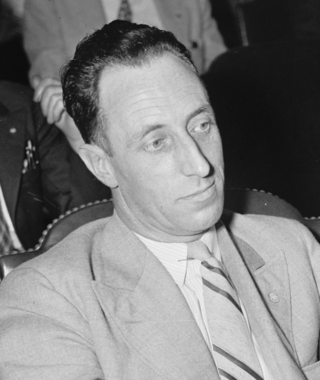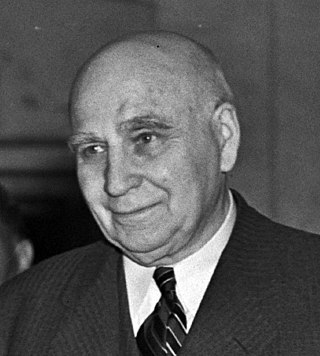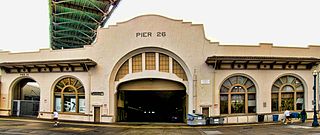
A stevedore, also called a longshoreman, a docker or a dockworker, is a waterfront manual laborer who is involved in loading and unloading ships, trucks, trains or airplanes.

Harry Bridges was an Australian-born American union leader, first with the International Longshoremen's Association (ILA). In 1937, he led several chapters in forming a new union, the International Longshore and Warehouse Union (ILWU), expanding members to workers in warehouses, and led it for the next 40 years. He was prosecuted for his labor organizing and designated as subversive by the U.S. government during the 1930s, 1940s, and 1950s, with the goal of deportation. This was never achieved.

Frank Finley Merriam was an American Republican politician who served as the 28th governor of California from June 2, 1934 until January 2, 1939. Assuming the governorship at the height of the Great Depression following the death of Governor James Rolph, Merriam defeated the Democratic candidate Upton Sinclair in the California gubernatorial election in 1934. Merriam also served as the State Auditor of Iowa from 1900 to 1903, and served in both the Iowa and California state legislatures.

The 1934 West Coast Waterfront Strike lasted 83 days, and began on May 9, 1934 when longshoremen in every US West Coast port walked out. Organized by the International Longshore and Warehouse Union (ILWU), the strike peaked with the death of two workers on "Bloody Thursday" and the San Francisco General Strike which stopped all work in the major port city for four days and led ultimately to the settlement of the West Coast Longshoremen's Strike.

The International Longshoremen's Association (ILA) is a North American labor union representing longshore workers along the East Coast of the United States and Canada, the Gulf Coast, the Great Lakes, Puerto Rico, and inland waterways. The ILA has approximately 200 local affiliates in port cities in these areas.

The Vancouver Police Department (VPD) is the police force for the City of Vancouver in British Columbia, Canada. It is one of several police departments within the Metro Vancouver Area and is the second largest police force in the province after RCMP "E" Division.

Major-General William Wasbrough Foster, CMG, DSO, VD was a noted mountaineer, Conservative Party politician, businessman, and chief constable in British Columbia, Canada, in addition to his distinguished military career.
The Battle of Ballantyne Pier occurred in Ballantyne Pier during a docker's strike in Vancouver, British Columbia, in June 1935.

The British Columbia Maritime Employers Association is an association representing the interests of member companies in industrial relations on Vancouver's and other British Columbian seaports.

The existing historic Pier 26 in San Francisco is located on the Embarcadero with its entrance directly under the San Francisco–Oakland Bay Bridge, several blocks southeast of the Ferry Building. The pier is a single story gable timber structure that rests partially on concrete retainage but mostly on pier foundations on the bay. Its surface area measures approximately 100,000 square feet (9,300 m2), currently used for parking and storage. Its front facade along the Embarcadero is of historic significance.

Harrald Olaf Lundeberg was a merchant seaman and an American labor leader.
The Waterfront Workers History Project is a program of the University of Washington, which serves to document the history of workers and unions active on the ports, inland waterways, fisheries, canneries, and other waterfront industries of the western United States and Canada, specifically, California, Oregon, Washington, Alaska, and British Columbia. In collaboration with the Pacific Northwest Labor and Civil Rights History Projects, and sponsored by the Harry Bridges Center for Labor Studies, the Project is a collective effort to organize and present historical data covering significant events from 1894 to the current day.

The Mechanization and Modernization (M&M) Agreement of 1960 was an agreement reached by California longshoremen unions: International Longshore and Warehouse Union (ILWU), the International Longshoremen's Association (ILA), and the Pacific Maritime Association. This agreement applied to workers on the Pacific Coast of the United States, the West Coast of Canada, and Hawaii. The original agreement was contracted for five years and would be in effect until July 1, 1966.

The International Longshore and Warehouse Union (ILWU) is a labor union which primarily represents dock workers on the West Coast of the United States, Hawaii, and in British Columbia, Canada. The union was established in 1937 after the 1934 West Coast Waterfront Strike, a three-month-long strike that culminated in a four-day general strike in San Francisco, California, and the Bay Area. It disaffiliated from the AFL–CIO on August 30, 2013.
The ILWU 1971 strike began on July 1, 1971, when members of the International Longshore and Warehouse Union (ILWU) walked out against their employers, represented by the Pacific Maritime Association (PMA). The union's goal was to secure employment, wages, and benefits in the face of increased mechanization, shrinking workforce, and the slowing economic climate of the early 1970s. The strike shut down all 56 West coast ports, including those in Canada, and lasted 130 days, the longest strike in the ILWU's history.
The Longshore Strike 1948 was an industrial dispute which took place in 1948 on the west coast of the United States. President of the ILWU at the time was Harry Bridges. The WEA led by Frank P. Foise were in a conflict, they were unable to come to agreeable terms and with the issues of hiring and the politics of union leadership, longshoremen and marine unions performed a walk out on September 2, 1948.
The strike shut down the United States’ West Coast ports and put a dent in American labor history and a positive change for future longshoremen.
The Portland Waterfront strike of 1922 was a labor strike conducted by the International Longshoremen's Association which took place in Portland, Oregon from late April to late June 1922. The strike was ineffective at closing down the Port of Portland due to strikebreakers, and on June 22 the strike ended with the employers dictating terms.

In the late 1870s, Squamish and Tsleil-Waututh communities on the North Shore of Burrard Inlet experienced an increase of physical and economic encroachment from the expansion of neighbouring Vancouver. Faced with urbanization and industrialization around reserve lands, Squamish and Tsleil-Waututh traditional economies became increasingly marginalized, while government-imposed laws increasingly restricted Native fishing, hunting, and access to land and waters for subsistence. In response, these communities increasingly turned to participating in the wage-labor economy.
The 1935 Gulf Coast longshoremen's strike was a labor action of the International Longshoremen's Association. Lasting for about ten weeks from October 1, 1935 to mid-December on the Gulf Coast of the United States, the strike was marked by significant violence.
Donald (Don) Peter Garcia was a Filipino Canadian union organizer mostly noted as the past president of the International Longshore and Warehouse Union (ILWU) Canadian Area.












